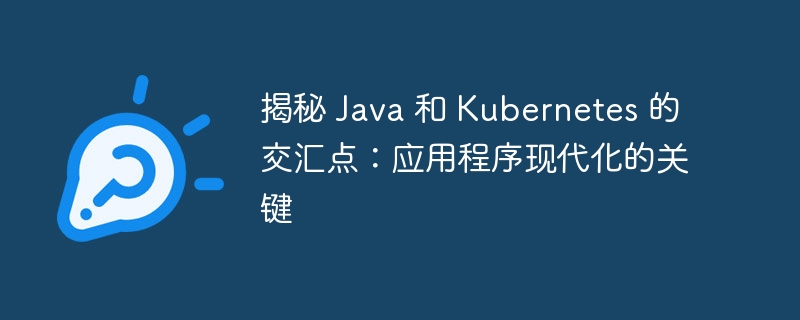 Java
Java
 javaTutorial
javaTutorial
 Uncovering the intersection of Java and Kubernetes: the key to application modernization
Uncovering the intersection of Java and Kubernetes: the key to application modernization
Uncovering the intersection of Java and Kubernetes: the key to application modernization

php editor Yuzi reveals the intersection of Java and Kubernetes and discusses the key to application modernization. The combination of Java, a popular programming language, and Kubernetes, an advanced container orchestration platform, provides new possibilities for application development and deployment. This article takes a closer look at where Java and Kubernetes come together and how they can be used together to drive application modernization.
Containerized Java Applications
Containers The process of packaging applications into portable execution environments called containers. Kubernetes is the container orchestration platform that manages and orchestrates these containers. Containerizing Java applications can bring many benefits, including:
- Quick Deployment: Containers can be quickly and easily deployed to Kubernetes clusters, reducing deployment time.
- Portability: Containers can run in any environment that supports Kubernetes, regardless of infrastructure.
- Scalability: Kubernetes can automatically scale containers up or down as needed to meet changing workloads.
Microservices and Kubernetes
MicroservicesArchitecture Break down an application into smaller, independent components called microservices. Kubernetes is ideal for managing microservices as it provides the following advantages:
- Service Discovery: Kubernetes automatically discovers and routes to microservices, simplifying communication between services.
- Fault tolerance: Kubernetes continuously monitors microservices and automatically restarts failed containers to ensure high availability.
- Automation: Kubernetes provides a wide range of automation tools that can simplify the deployment, management and monitoring of microservices.
Sample code
The following Spring Boot application demonstrates how to deploy Java applications on Kubernetes:
@SpringBootApplication
public class DemoApplication {
public static void main(String[] args) {
springApplication.run(DemoApplication.class, args);
}
}To deploy this application, you can use the following Kubernetes manifest:
apiVersion: apps/v1 kind: Deployment metadata: name: demo-app spec: selector: matchLabels: app: demo-app template: metadata: labels: app: demo-app spec: containers: - name: demo-app image: "my-image:latest" ports: - containerPort: 8080
in conclusion
The intersection of Java and Kubernetes is shaping the application modernization landscape. Containerizing and deploying Java applications on Kubernetes brings significant benefits, including rapid deployment, portability, scalability, and automation. By leveraging the power of Kubernetes, Java developers can build modern, high-performance applications to meet changing business needs.
The above is the detailed content of Uncovering the intersection of Java and Kubernetes: the key to application modernization. For more information, please follow other related articles on the PHP Chinese website!

Hot AI Tools

Undresser.AI Undress
AI-powered app for creating realistic nude photos

AI Clothes Remover
Online AI tool for removing clothes from photos.

Undress AI Tool
Undress images for free

Clothoff.io
AI clothes remover

AI Hentai Generator
Generate AI Hentai for free.

Hot Article

Hot Tools

Notepad++7.3.1
Easy-to-use and free code editor

SublimeText3 Chinese version
Chinese version, very easy to use

Zend Studio 13.0.1
Powerful PHP integrated development environment

Dreamweaver CS6
Visual web development tools

SublimeText3 Mac version
God-level code editing software (SublimeText3)

Hot Topics
 1359
1359
 52
52
 Square Root in Java
Aug 30, 2024 pm 04:26 PM
Square Root in Java
Aug 30, 2024 pm 04:26 PM
Guide to Square Root in Java. Here we discuss how Square Root works in Java with example and its code implementation respectively.
 Perfect Number in Java
Aug 30, 2024 pm 04:28 PM
Perfect Number in Java
Aug 30, 2024 pm 04:28 PM
Guide to Perfect Number in Java. Here we discuss the Definition, How to check Perfect number in Java?, examples with code implementation.
 Random Number Generator in Java
Aug 30, 2024 pm 04:27 PM
Random Number Generator in Java
Aug 30, 2024 pm 04:27 PM
Guide to Random Number Generator in Java. Here we discuss Functions in Java with examples and two different Generators with ther examples.
 Armstrong Number in Java
Aug 30, 2024 pm 04:26 PM
Armstrong Number in Java
Aug 30, 2024 pm 04:26 PM
Guide to the Armstrong Number in Java. Here we discuss an introduction to Armstrong's number in java along with some of the code.
 Weka in Java
Aug 30, 2024 pm 04:28 PM
Weka in Java
Aug 30, 2024 pm 04:28 PM
Guide to Weka in Java. Here we discuss the Introduction, how to use weka java, the type of platform, and advantages with examples.
 Smith Number in Java
Aug 30, 2024 pm 04:28 PM
Smith Number in Java
Aug 30, 2024 pm 04:28 PM
Guide to Smith Number in Java. Here we discuss the Definition, How to check smith number in Java? example with code implementation.
 Java Spring Interview Questions
Aug 30, 2024 pm 04:29 PM
Java Spring Interview Questions
Aug 30, 2024 pm 04:29 PM
In this article, we have kept the most asked Java Spring Interview Questions with their detailed answers. So that you can crack the interview.
 Break or return from Java 8 stream forEach?
Feb 07, 2025 pm 12:09 PM
Break or return from Java 8 stream forEach?
Feb 07, 2025 pm 12:09 PM
Java 8 introduces the Stream API, providing a powerful and expressive way to process data collections. However, a common question when using Stream is: How to break or return from a forEach operation? Traditional loops allow for early interruption or return, but Stream's forEach method does not directly support this method. This article will explain the reasons and explore alternative methods for implementing premature termination in Stream processing systems. Further reading: Java Stream API improvements Understand Stream forEach The forEach method is a terminal operation that performs one operation on each element in the Stream. Its design intention is



